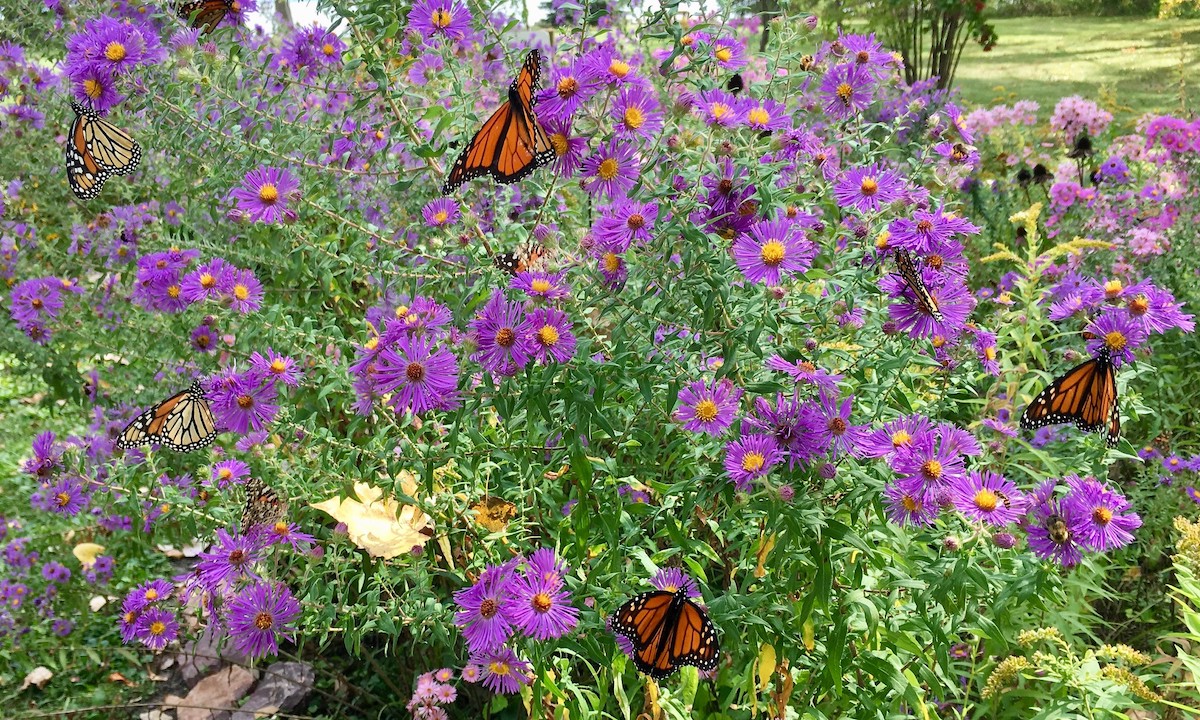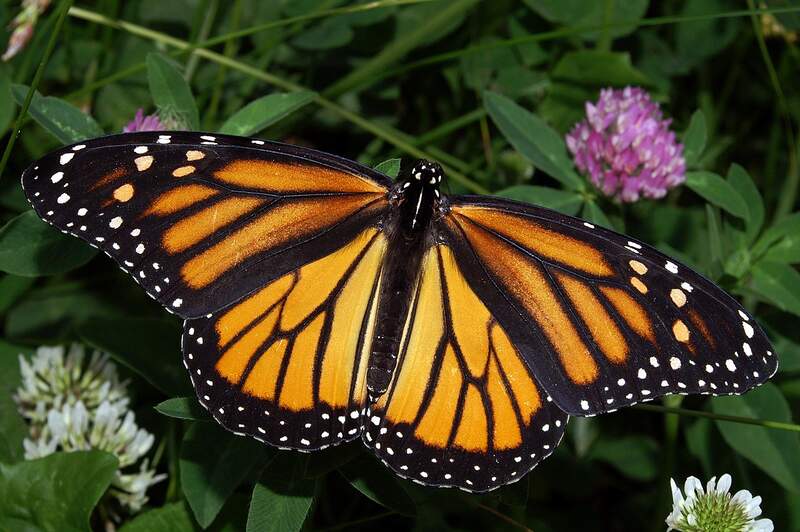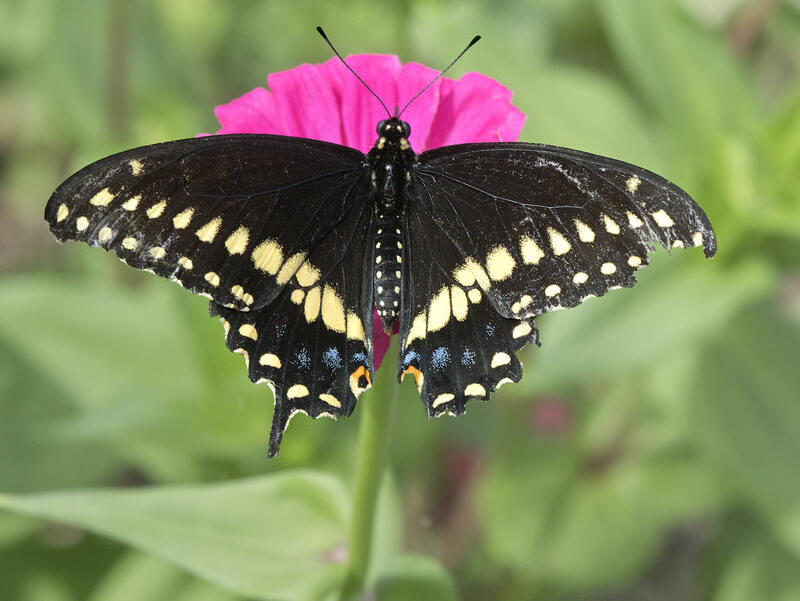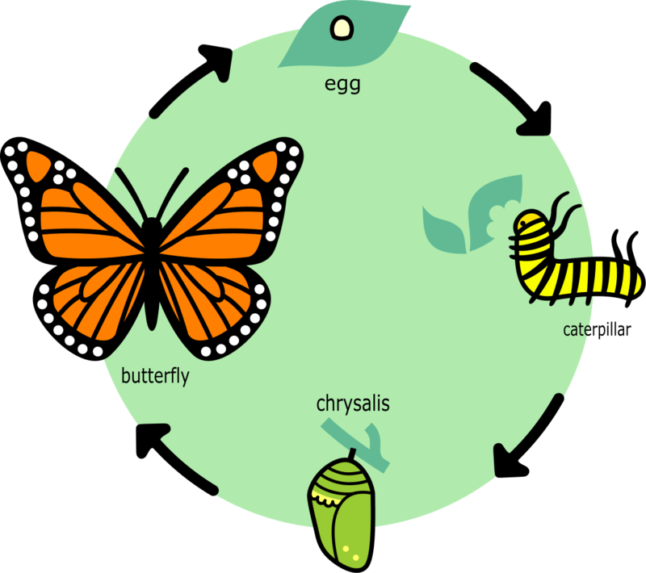
Creating a butterfly garden can be just the kind of do-it-yourself project that is worthy of your energy and your time. But remember this: The goal isn’t merely to attract butterflies, but to get butterflies to stay, reproduce, and live out their life cycle. That is the goal when you review how to design a butterfly garden.
How to Make a Butterfly Garden

Before we probe into specific plants, bloom time, varying heights, and other details, here are six pillars of butterfly garden design:
- Area: Dedicate an area that covers about 100 square feet. Round areas are common, square areas are often used, but rectangular shapes (5 by 20) also work. But there must be space.
- Sunlight: The butterfly garden needs 6 to 8 hours of sunlight per day. More is fine.
- Variety: Plan to plant a lot of flowers. Plant flowers of different shapes, sizes, heights, and colors. (See the next section for specific plants.)
- Nectar/host plants: Butterflies sip their nectar from flowers using a straw-like proboscis (pronounced pruh-BAAS-is). Caterpillars chomp and chew on host plants (that is, a plant on which a creature lives and feeds). Be sure to include both kinds of food.
- Water: Add a small clay saucer or birdbath with sand or small pebbles in the bottom and shallow water for butterflies.
- Rocks: Place light-colored rocks. It gives butterflies places to linger in the sunlight when it is cool.
A fun tip: Place decaying fruits, such as bananas, oranges, peaches, or strawberries left over from your dinner, in a shallow container as a food source for butterflies. Drizzle a mix of brown sugar, molasses, and beer over the fruits. Butterflies love such a sugary brew and it keeps the fruit moist.
Select Your Butterfly Garden Plants

One of the pleasures of having a butterfly garden is that it can add a great deal of color, not only from the adult butterflies, but from plants they favor.
Planting tip: Plant your colorful blooming plants in groups. This helps butterflies identify the blooms more easily.
| Flower | Primary colors |
| Asters | Purple, white, blue, pink |
| Bee Balm (Bergamot) | Red, pink, purple, white |
| Black-Eyed Susans | Yellow, orange, red, with brown center |
| Coneflowers | Purple, pink, red, orange, white, yellow |
| Joe-Pye weeds | Pink, purple |
| Marigolds | Orange, yellow, red, mahogany |
| Sunflowers | Yellow with a brown center |
| Verbena | Reds, whites, pinks, purples |
| Zinnias | Pink, orange, red, yellow, peach, white |
Have an herb garden? Most plants in the mint family provide nectar for butterflies, too.
A warning: Despite having “butterfly” in its name, a butterfly bush is not a good plant for a butterfly garden. It is categorized as an invasive species, crowding out other plants. Some states ban them.
Grow Caterpillar-Friendly Host Plants

Monarch butterflies have such a connection to milkweed that they are sometimes called “milkweed butterflies.” Milkweed is the only host plant for monarch caterpillars, and also serves as a nectar source for adults (though adults feed on other plants, too).
Some other caterpillar host plants:
- Passionflower vines: Gulf fritillary caterpillars love them.
- Sunflowers: Painted lady caterpillars like many plant varieties, but especially sunflowers.
- Willows: Eastern tiger swallowtail caterpillars like these woody plants.
Monarch butterflies and black swallowtail butterflies are the most common butterflies. Among other things, they are quite pretty, and quite prolific.

Photo Credit: Kenneth Dwain Harrelson / Wikimedia Commons / CC BY 2.0

Photo Credit: C Watts / Flickr / CC BY 2.0
Provide a Butterfly Puddling Station


Mud-puddling or puddling is a behavior in butterflies and other insects in which they seek out moist, muddy areas where they can perch and suck up liquid, not only getting water, but extracting minerals from the soil.
How you make a puddling station as part of your butterfly habitat:
- Fill a shallow container or saucer with mud or sand. Ensure the mud and sand are free of fertilizer and pesticides. For a good source of minerals, sprinkle in compost or natural sea salt.
- Fill the container with water until the mixture is moist. You don’t want the water level to get too high so that the butterflies have nowhere to perch. The mix should be just wet enough so the butterflies can get their fluids and have a safe spot to perch.
- Place it in the sunlight. Butterflies love the sun.
- Check it daily. To be sure it is still moist. When it isn’t, simply add more water.
- Add overripe fruits to help attract butterflies.
Be Careful About Pesticides

- Butterflies are sensitive to pesticides, so they won’t be sticking around your garden for long if you smother it with pest control chemicals.
- Try natural remedies if pests are an issue in your butterfly garden. For example, use insect-repelling flowers to ward off specific pests while remaining butterfly-friendly. Chrysanthemums keep away ants, Japanese beetles, roaches, silverfish, ticks, and spider mites.
- Non-toxic pesticides are being offered. The Environmental Protection Agency offers a list of 251 of them. But remember: The use of any of them creates the risk of driving away the butterflies, too.
While you create a plan to eliminate pesticides, why not go a few steps further and create a certified wildlife habitat? In doing so, you’ll invite not only butterflies but bees, birds, and other wildlife to have a safe place to eat, drink, shelter, and raise their offspring.
Whether you’re building a certified wildlife habitat, butterfly garden, or pollinator garden, the first step is to find alternatives to pesticides and go chemical-free in your landscape. Take this first step today!
Vary Blooming Heights

Don’t forget that there are butterflies that will prefer to feed at higher levels. With that in mind, you have to include some features of height in your butterfly garden. Use these ideas to create flowers at different heights in your garden:
- A hanging flower basket. If it is colorful, it enhances the color of the flowers it holds.
- A trellis. Think tall and arched over a walkway or straight along a fence. There are countless trellis ideas to choose from.
- Blooming vines, on a trellis or fence. Flowering vines add height, food, shelter, and beauty to your landscape.
A pro’s tip: Keep in mind that you might like to walk through a butterfly garden in which the butterflies are dancing above your head, flitting past your ankles, and maybe even perching on your arms.
Diversify Blooming Times

Avoid growing plants that will all bloom at once. While a simultaneous bloom may look wonderful for a few short weeks, this is not enough time to sustain multiple butterflies and their offspring. There is no shortage of choices of plants, both perennials and annuals, to last through the spring, summer, and fall.
For example, here are 10 plants commonly placed in butterfly gardens and their blooming periods:
| Plant | Scientific name | Blooming period |
| Aster | Aster spp. | July-September |
| Black-eyed susan | Rudbeckia hirta | July-August |
| Geranium | Geranium spp. | April-June |
| Marigold | Tagetes spp. | May-September |
| Milkweed | Asclepias spp. | June-August |
| Phlox | Phlox drummondi | June-August |
| Purple coneflower | Echinacea | July-September |
| Sunflower | Helianthus spp. | July-October |
| Verbena | Verbena spp. | June-September |
| Zinnia | Zinnia spp. | July-September |
In addition, you might keep in mind that native plants in your area are ideal choices. They can add color and heritage to your butterfly garden.
Caution: Be sure any purchased plants have not been treated with neonicotinoids, a class of insecticides that are dangerous to pollinators. You may have to research the seller to find out, but it’s worth it to ensure the butterflies have a safe, healthy meal.
Create Shelter

Butterflies are attracted to shelter. To offer it in your butterfly garden, grow shrubs and trees. They offer:
- A safe place to rest at night
- A refuge on rainy days
- Windbreakers
Shrubs and Trees that Provide Shelter for Butterflies
| Shrub/Tree | Scientific name | Blooming time |
| Buttonbush | Cephalanthus occidentalis | June-August |
| Eastern redbud | Cercis canadensis | March-May |
| Fragrant sumac | Rhus aromatica | March-April |
| Ninebark | Physocarpus opulifolius | May-June |
| Spicebush | Lindera benzoin | February-March |
| Wild hydrangea | Hydrangea arborescens | May-July |
| Wild plum | Prunus americana | March-May |
Source: Missouri Department of Conservation
Butterfly Basics
Can’t get enough of these pollinators? Here are more fun facts you might want to know:
- Numbers. Some 17,500 species in the world, 750 species in the United States.
- Distinctive characteristics. Scales covering their wings, unlike other insects. Another difference: Butterflies can roll up their proboscis (pronounced pruh-BAAS-is).
- Relationship with plants. Caterpillars eat plants, but butterflies are needed for cross-pollination.
- Migration. They are capable of traveling great distances. The Monarch regularly migrates 3,000 miles.
- Vision. Excellent, which is why they can avoid obstacles as they fly.
- Mating. Courtship rituals vary among species, but females can mate on the day they emerge while males wait several days.
Butterflies Do Better in a Garden
Butterflies create more eggs, a process with the scientific name “oviposition,” in a garden as opposed to being in nature, according to a study by Brian T. Cutting and Douglas W. Tallamy of the University of Delaware. In their study, they monitored 60 sites.
The study also found that the survival rate of eggs in gardens was roughly the same as that of eggs produced in nature.
Source: Environmental Entomology, October 2015
Life Cycle of a Butterfly

When to Call a Professional Landscaper
Sometimes arranging the flowers in your butterfly garden can feel like a challenge if you haven’t got an eye for texture and color. And if you’re not a green thumb, digging in the dirt may not be your strong suit.
So whether you’re new to butterfly gardening or need design advice, there’s no reason to away from building a butterfly garden in your backyard. Call a professional landscaper near you for assistance with design ideas, planting, or maintenance.
With the help of a professional, you can turn your butterfly garden dreams into reality.
FAQs
As natural habitats begin to dwindle due to wildfires, climate change, and deforestation, your butterfly garden can act as a sanctuary for these beautiful creatures, especially for endangered butterflies.
Building a butterfly garden becomes an easier task once you know it will become a safe habitat for butterflies seeking refuge.
Lifespans vary among butterfly species. Some live for a few months, while others may complete their life cycle in a few short weeks.
According to the U.S. Forest Service, monarch butterflies typically live between two and six weeks, except for the last generation of the year, which can live up to eight or nine months.
The black swallowtail has a very short lifespan, only living up to 10 to 12 days.
● Visit a nearby butterfly house or butterfly museum and speak with a professional about butterflies in your area.
● Speak with nearby butterfly gardeners. They will have helpful tips.
●Invest in a field guide. This handy tool will provide information on different kinds of butterflies and the food plants they prefer.
A Call to Action
You can have a beautiful butterfly garden, and you can create one as a DIY project. But to do it properly, you must take action: Design it so that it meets all of your needs … and those of the butterflies. If you do not have the time or energy, call in a local landscape professional. Designs don’t happen; they take work.
Additional sources:
Main Image Credit: Laura Bernhardt / Flickr / CC BY-ND 2.0